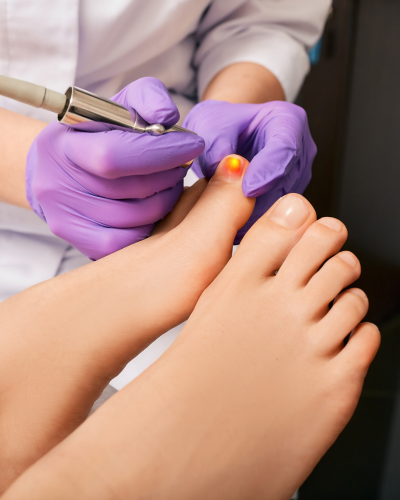
Nail Dust and Risk Management
Occup Environ Med. 2006 October; 63(10)
World at work: Evidence based risk management of nail dust in chiropodists and podiatrists
An overview of hazards and risks
Keywords: occupational health, nail dust, risk reduction strategy, podiatry
Podiatrists work in general and specialised clinics, providing essential assessment, evaluation, and foot care for a wide range of patients. Many people have long standing local foot as well as systemic problems for which there is no cure, therefore the podiatrist's role is to keep these people mobile and make a real difference to their lives. Most podiatrists have a percentage of “general practice” work in their caseload, but over time they decide to specialise in certain areas: diabetes, biomechanics, rheumatology, children's feet (podopaediatrics), orthoses manufacture, or sports injuries. The role of the podiatrist is much wider than most people realise.
Podiatrists treat diabetic foot ulcers, using sharp debridement; reduce long thickened and distorted toenails in the elderly; and treat high risk foot conditions such as poor vascular supply which leads to poor healing, gangrene, and in some extreme cases, amputation. Their expertise is in reducing these conditions, minimising foot deformities, supplying advice, and referral to other members of the healthcare team to ensure optimum foot health and care in order not to put clients at risk of amputation or disability through deformities or pain.
However, as with any job or profession, hazards and risks are associated with these practices. There are a number of risk factors associated with podiatry:
- Musculoskeletal disorders, including repetitive strain injury (RSI) (also known as work related upper limb disorders (WRULD). These occur as a result of the various working postures and workload: podiatrists may encounter clients in their own homes, within residential and care homes, or within the ward or hospital setting, where workstation conditions and the environment are far from ideal. RSI may occur due to the large caseloads together with the repetitive nature of some tasks which use similar hand grips for long periods without breaks. Instrumentation in some cases is adapted from that of other professionals and is not designed specifically for podiatrists; in some NHS establishments, no cognisance is made of gender differences or hand size and grip strength difference when supplying instruments which are used for long periods.
- Microbial dust—may arise from reducing calluses, corns, nails, or the normal desquamation of skin cells during treatment
- Latex allergies—latex gloves are used during treatment of clients or nail surgical procedures; gloves may be used indiscriminately due to a lack of suitable and sufficient risk assessment
- Chemical hazards—a variety of chemicals are used to reduce calluses or corns; decontaminate instruments; disinfectant the skin; and treat fungal and other infections
- Blood borne viruses—a variety of patients may present with hepatitis B or C, or be HIV positive; the podiatrist is at risk through the use of sharp scalpels for debridement of calluses and ulcers.
This article however, will focus on one of these (microbial dust), and discuss whether workers can be protected from the occupational health effects of microbial dusts by using the risk reduction strategy of the Health and Safety Executive.1 However, it is not just podiatrists facing this risk, but also foot care assistants, beauticians, nail bar technicians, and others in the health and beauty industries, and perhaps also the clients being treated.
Microbial dust as a risk factor
Debate has ensued since 1972, as to whether nail dust was harmful and could be considered an occupational risk factor.2,3,4,5,6 Podiatrists, along with other health/beauty care workers, are exposed to fine respirable particles of dust created when filing or drilling fingernails or toenails, which also have the potential for eye injuries.7,8,9 Research by Millar10 suggested that, within podiatry, there was four times the national prevalence of asthma, giving cause for concern. In the same study, podiatrists reported problems with rhinitis and conjunctivitis regularly, suggesting occupational health risks. Breathing in substances termed respiratory sensitisers at work can cause occupational asthma.11
We conducted a series of studies investigating possible transmission routes of microorganisms from human toe nails to respiratory and ocular systems, determining the types of microorganisms encountered. Ethical approval was obtained from South Glasgow Local Research Ethics Committee.
Size of nail dust particles
The size of nail dust particles is estimated to be 0.8–1.6 µm; the majority are <5 µm,12 suggesting deposition in the alveoli and bronchioles.13 The turbines of drills used to reduce nails or skin, create an aerosol of bacteria, which remains in the air for up to 30 minutes.14
Microorganisms encountered.
Microorganisms were isolated from randomised collecting bags of drills used to reduce nails (table 1​1).). The drill burr rotates at a given speed, reducing (sanding or thinning) the nail, whereby dust enters the dust bag via the shroud at the drill bit by a local exhaust ventilation system (LEV). The possibility of transmission, by aerosolisation, of blood and body fluids of hepatitis B or HIV,15 or through the conjunctiva16,17 exists. The smaller airborne particulates create an aerosol with distribution throughout the respiratory system18,19,20,21 and damage to immunocompromised clients.22
Reported health problems
Millar10 reported that 39% of respondents to a postal questionnaire described known allergies, 51% reported eye problems, 18.6% chest complaints, 22.6% skin problems, while 65.4% reported routinely drilling thickened toenails. Additionally 64% believed that drilling nails posed a risk to their eyes, but <10% routinely wore eye protection. Only 25% routinely serviced drills.
Risk assessments and transfer routes
Observational risk assessment suggested potential routes of transfer of dust to the eye via three vectors:
- Hand contamination
- Via the air of the clinical environment
- Direct onto the eye surface (lack of/inadequate eye protection); missiles of air particles.
The possible routes of transfer to the lungs were:
- Direct inhalation (lack of/inadequate protective equipment for face)
- Contamination of the air and therefore breathing contaminated air
- Possible handâ€toâ€face contamination.
Possible reasons for direct inhalation were:
- Positioning of podiatrist to nail being reduced
- Quantity and size of dust particles created
- Poor maintenance of drill and therefore poor LEV
- Poor/inappropriate use of burr size, shape, and abrasiveness
- Poor original extraction system and inefficiency of drill
- No environmental filtration/extraction system.
Air sampling studies
To determine air routes and microbial species, air sampling studies using a surface air sampler (Cherwell Laboratories) and a variety of agars were conducted.
The fungal microorganisms isolated via the air study were identified those identified using similar agars for a hand contamination study are also presented. Hand pieces of drills also harbour infectious substances
Dermatophyte fungi account for approximately 80–90% of all nail infections (onychomycosis).25Trichophyton rubrum, a causative organism in bronchial asthma, causes other symptoms, e.g. rhinitis, allergic hypersensitivity diseases.26,27,28,29 Studies have shown that podiatrists have antibodies to this organism, suggesting routine exposure to it;21,30,31 hypersensitivity reactions to nail dust have also been proposed.30,31,32 A number of studies20,33,34,35,36,37 report that efficiency, and therefore effectiveness of LEVs vary with drill type, speed, burr shape, size, and coarseness/abrasiveness of the burr.
Recent studies38,39,40 clearly show the benefits of an air filtration system, reducing overall clinical air contaminants by an average of 60+%.
The researched evidence supports the theory of an occupational ocular and respiratory health risk from nail dust. A risk reduction strategy1 could effectively reduce exposure levels to nail dust.
Attempts to reduce exposure to nail dust
The key elements of any risk reduction strategy are:
- Elimination
- Avoidance
- Exchange for a less harmful substance.
Refusing to drill or file nails is unethical, but would eliminate and avoid exposure to nail dust. The ability to exchange the substance for something less harmful is not viable except where the clinician suspects a fungal nail; mycology results are obtained before drilling. In the beauty industry, synthetic/acrylic nails should not be drilled/shaped by healthcare workers/beauticians without adequate protection; these could be exchanged for a less dangerous substance.
Engineering controls
The first engineering control is a good quality, effective, efficient dust extraction system (LEV), both locally and centrally, requiring independent regular testing. The benefits of a secondary extraction/filter system within the clinic, additional to the drills extraction system, which ensures filtration and reduced air contamination within the environment, are emerging.38,39,40
Maintenance of the drill, dust bag, and extraction system are required, ensuring optimum efficiency and effectiveness. Cleaning hand pieces ensure reduced contamination, while cleaning the drill housing inside ensures that dust which has penetrated to the insides does not return through the housing and back to the environment without further filtration. Therefore, use of a secondary filter for returning air to the environment is the best practice.
Drilling technique
The drilling technique can reduce the amount of small particles produced:
- Torque of drill—speed is not as important as torque
- Shape of burr determines how dust extraction into the shroud occurs. If the burr shape is square, or barrel shaped, or sits close to the shroud housing, dust may bypass the orifice and not be extracted, leaving more in the atmosphere to be inhaled
- Coarseness of burr—start with a course burr, working down to the finer burr for finishing off, ensuring particles created are courser/larger, and less likely to be inhaled.
Education, information, and training
Education providers for beauticians, nail bar technicians, chiropodists, and podiatrists need to train and educate staff in the purchase, maintenance, and servicing of nail drills, the technique of drilling, identification of suspect fungal nails, and ensuring safe systems of work are incorporated into general practice.
Personal protective equipment
Personal protective equipment is designed to protect the respiratory and ocular systems.42
Eye protection should conform to BS2092 and EN166,43 and include markings for dust and the grade of ability to withstand velocity of particles (e.g. 120 m/s, grade 1) together with the trademark/licence/name of manufacturer.
Face masks should conform to the European Standard EN149. Single use, disposable respirators, suitable for fine dust as encountered in podiatry include the following classifications:
- FFP1: fine, non-toxic dusts and fumes; 4.5 × OEL (occupational exposure limit)
- FFP2: fine, non-toxic dusts, fibres, and aqueous mists; 12.5 × OEL
Conclusions
Adoption of this strategy reduces the occupational exposure and therefore the occupational health risks of those practitioners exposed to human nail dust.
Acknowledgements
The authors would like to acknowledge the help and assistance of the following: Professor Kofi Aidoo, Microbiologist, School of Life Sciences; Dr Mike Hepher, Reader, School of Built and Natural Environment; Dr William Maclaren, Senior Lecturer, School of Mathematics and Computing, Glasgow Caledonian University; Mr Jon Young, Purex Ltd, Rotherham, UK; and Mr Paul Gregory, Lenson Metal Products Ltd, UK.
